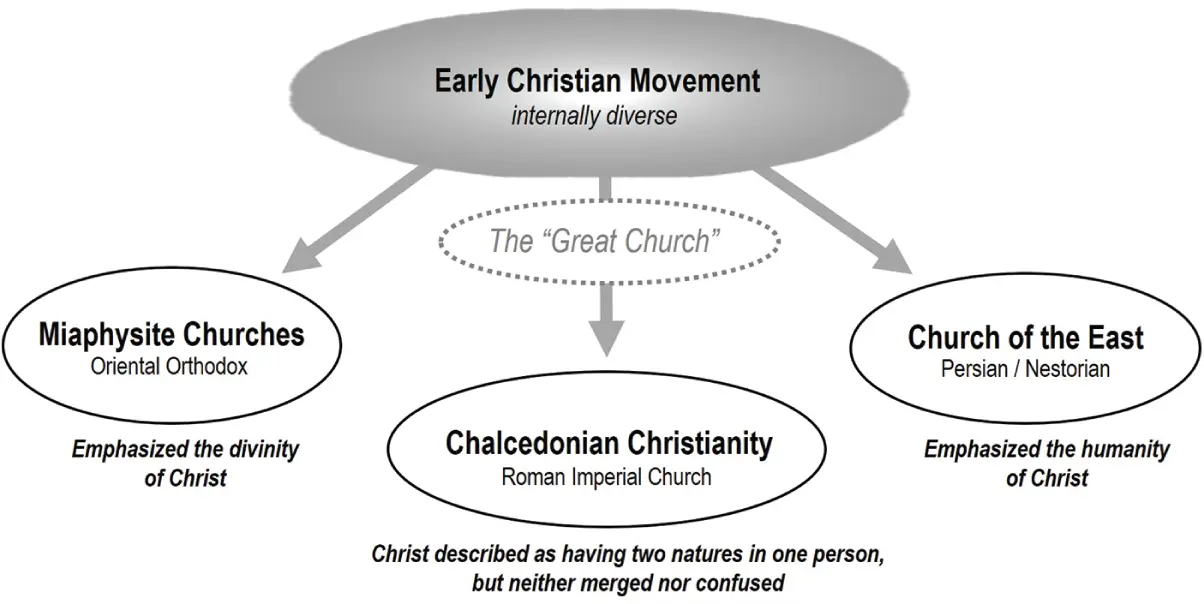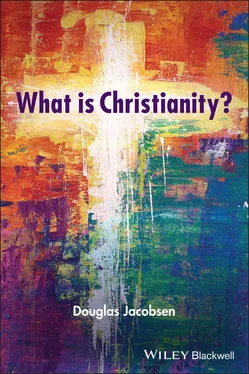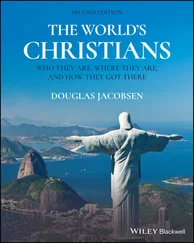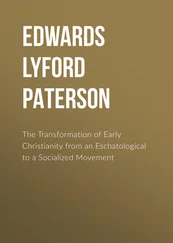Theological differences alone do not create a schism. Breaks as significant as the Great Division require an institutional component, as well, and that component was largely supplied by Jacob Baradeus (500–578), bishop of the city of Edessa (in what is now southern Turkey). During the middle of the sixth century, bishop Jacob traveled thousands of miles back and forth across the Middle East (both within and outside the Roman Empire) in order to ordain hundreds of priests and dozens of bishops to be part of a new Miaphysite church hierarchy standing in opposition to the Roman Imperial Church and the Chalcedonian beliefs it championed. Because of his efforts, the Miaphysite tradition (especially in Syria) is also known as the Jacobite Church. Non-Chalcedonian Christians in Egypt had established their own institutional independence even earlier under the leadership of a Miaphysite bishop called Timothy the Cat (d. 477). Miaphysite Christians living within the borders of the Roman Empire were sometimes subjected to brutal persecution by the Roman government (with the support and blessing of the Imperial Chalcedonian-oriented Church), which Miaphysite Christians interpreted as indisputable evidence that Chalcedonian Christianity was itself heretical. How, they asked, could any follower of Jesus condone such violence against other Christian believers when Jesus himself had commanded his disciples to love each other?
Meanwhile, the Church of the East tradition diverged from Chalcedon Christianity in the opposite direction from the Miaphysites. Instead of seeing Christ’s personhood as a merger of the human and divine, Persian Christians stressed the separateness of the human and the divine in Christ. Persian Christians viewed ethics as central to Christian faith, and they accordingly viewed Jesus not only as a spiritual savior, but also as moral model for life. If Christ was to serve in this role, however – if Christ was to be seen as a realistic model for people to follow – he had to be fully and genuinely human and not somehow superhuman. One of the most well-known leaders of the Church of the East, the long-lived Catholicos Timothy I (728–823), made the argument that Christ had accomplished everything necessary for human salvation before his baptism by John in the River Jordan and that Christ remained on earth for three more years solely for the purpose of teaching his followers how they should live. Christ’s death on the cross was part of this instruction, and it showed Christians that they should not retaliate even when unjustly attacked by others. In contrast to Chalcedonians and Miaphysites who sometimes treated Christ’s humanity almost as an afterthought, the Church of the East placed Christ’s humanity at the center of their faith. (See Figure 1.3 for a summation of the Great Division and its Christological differences.)

Figure 1.3 Diagram of the Great Division summarizing Christological differences.
The Church of the East was the most missionary-minded of the three traditions formed by the Great Division, and its missionary-monks spread the gospel all along the Silk Road, a series of ancient trade routes that meandered across Central Asia and connected China with the Middle East. The cities and towns that dotted the Silk Road tended to be religiously diverse, as trade centers often are, and Christians in this environment quickly ascertained that an embracing message of welcome was much more effective than criticizing other religions. Church of the East missionaries reached the Chinese capital city of Chang’an (known as Xi’an today) in the year 635. The Chinese emperor was deeply impressed by their positive message, which focused on Christ as a teacher and stressed the virtues of kindness and compassion. One Church of the East sutra (poetic sermon) from those years reads in part:
Every being takes its refuge in You
And the light of Your Holy Compassion frees us all…
Great Teacher, I stand in awe of the Father.
Great Teacher, I am awed by the Holy Lord.
Great Teacher, I am speechless before the King of the Dharma.
Great Teacher, I am dazzled by the Enlightened Mind –
Great Teacher, you do everything to save us.
Everything looks to You, without thinking. Shower us with Your Healing Rain! Help us to overcome, give life to what has withered, And water the roots of kindness in us. 4
The Chinese emperor dubbed Christianity the “religion of light,” and he permitted the Church of the East to build monasteries wherever it desired. The Church of the East flourished in China until the mid-800s when China took a sudden xenophobic turn. Both Buddhist and Christian missionaries were expelled from the country, but Christianity seems to have been especially impacted, perhaps because the leadership of the movement remained mostly non-Chinese. Church of the East missionaries returned to China in the tenth century but never regained the prestige they formerly had enjoyed. Outside of China, the Church of the East maintained a significant presence in Persia and Central Asia until the fourteenth century when it finally withered under intense Muslim persecution.
The “Traditioning” of Christianity
The three traditions that emerged from the Great Division all saw themselves as legitimately tracing their roots back to Jesus, and each of them perceived their own beliefs and practices as a matchless effort to remain faithful to the gospel. All three groups continued to share a handful of beliefs and practices (for example, all of them believed God was a Trinity and all of them practiced the rites of baptism and the Eucharist), and a few genuinely exemplary individuals (like Isaac of Nineveh) were venerated as saints in all three traditions. However, their differences mattered. It was no longer possible to describe oneself simply as a Christian. After the Great Division, Christian identity required an adjective. You were a Chalcedonian Christian or a Miaphysite Christian or a member of the Church of the East, and it was no longer religiously meaningful to say one was simply a Christian without adding an additional signifier. To a large extent, this remains true today. The dominant Christian traditions have changed over the centuries, but the vast majority of Christians around the world continue to be affiliated with only a very few major traditions.
The root meaning of the word “tradition” is “to hand down,” and Christian traditions are specific packages of religious beliefs, actions, and attitudes that have been handed down by a particular religious community from generation to generation. When some people hear the word “tradition,” they equate it with “unchanging.” For them, tradition represents the way things have always been, year after year, decade after decade; tradition is old fashioned and changeless. But this way of thinking is mistaken. Traditions evolve and grow, albeit often slowly, and handing anything down from generation to generation is a complicated and unpredictable process. In reality, religious traditions are long, multigenerational conversations which can involve a significant amount of argument and conflict. New generations add their own perceptions and concerns to the conversation, sometimes affirming and sometimes critiquing or revising what was done in the past, and older generations (and their contemporary supporters) are sometimes appalled, saddened, or infuriated by those changes. Occasionally, tensions become so great that communities feel compelled to divide, but usually some kind of compromise is reached, and the community moves forward together.
Over the course of the 1500 years since the Great Division, Christianity has been carried through history by only a handful of major traditions. In the year 650, the Christian world was dominated by the three traditions known as Chalcedonian, Miaphysite, and Church of the East. By the year 1100, the Chalcedonian tradition had divided in two, creating the separate and distinct Eastern Orthodox and Roman Catholic traditions. Five hundred year later, Catholicism and Orthodoxy had become Christianity’s foremost traditions because the Church of the East had been persecuted into near oblivion and the Miaphysite churches had been severely reduced in size and influence, as well. Since 1500, the Catholic and Orthodox traditions have been joined by two other major Christian traditions: Protestantism, which began in the early 1500s, and Pentecostalism, which first took shape around 1900.
Читать дальше













